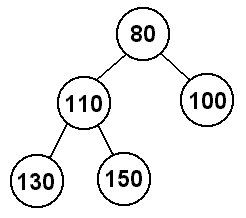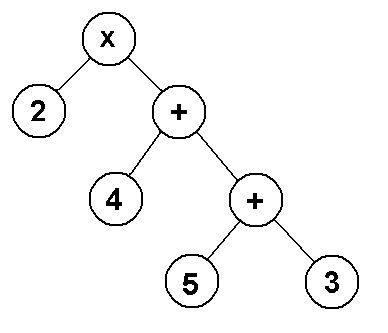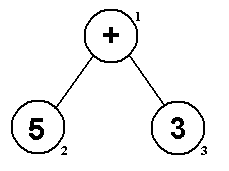Return to the Lecture Notes Index
15-111 Lecture 21 (March 16, 2009)
Trees
So far this semster, we've discussed a few different ways of organizing
information. Initially, we reviewed 15-100: we talked about the
simple case: simple, single, items, and aggregations there of. Then, we
talked about indexed lists: The array and corresponding ArrayList. Next,
we talked about linked lists: sequential but unindexed lists.
Today, we are going to talk about trees. Trees are data structures defined by
the parent-child relationship. A node of a tree can have many
children, but exactly one parent. In most trees, there is a single
distinguised node, or a "starting point", much like the head of
a linked list. We call this distinguished node the root of the
tree. By convention we draw the root of the tree, in trees that have a root,
at the top. Take a look at the tree below:

We see the root node, 80, at the top. Notice that the root is the only node
without any children. Notice also that nodes 100, 130, and 150 have no
children. We call these these nodes leaves. Any node without children
is called a leaf. It is possible for the root node to be a leaf.
Any node with children is known as an interior node. The root can
be either an interior node or a leaf.
In talking about trees, the terms heightdepth are
easily confused. We talk about the depth of a leaf. The depth
of a leaf is the distance between the leaf and the root. The depth
between the root and itself is 0. In our example above, the dpeth of 110
is 1 and the depth of 150 is 2.
The height of a tree is the depth of its deepest node. So,
paradoxically, a tree with a single node has a height of 0. The height
of an empty tree is undefined, as there is nothing to measure.
It is important to note that a node's descendant can never be an ancestor.
This would create what we call a cycle, or a loop. Trees cannot
have cycles. It is also worth noting that trees don't necessarily have to
have a distinguisehd node. It is possible to have a rootless tree, but these
are beyond the scope of 15-111, to be sure.
In 15-111, we are going to discuss only one type of tree: The Binary
Tree. A binary tree is a tree in which a node can have at most
two children, hence binary. Binary trees are straight-forward
to represent and are extremely useful for many types of problems.
Expression Trees
An expression tree is a binary tree which is used to represent a mathematical
expression. For example, if we have the expression (2 * (4 + (5 + 3))), we
could construct a tree to represent it.

In an expression tree, the parent nodes are the operators, and the children
are the operands. To find the result of this expression, we need to first
solve (5 + 3), which is 8, then solve (4 + 8), which is 12, and then
finally solve 2 * 12, which is 24. So our root node will contain the
operator within the outermost set of parentheses, it's left child will be
the value "2", and the right child will be the remaining expression that
needs to be solved, which would be (4 + (5 + 3)).
When we talked about solving expressions using stacks, we had three
different ways we could represent an expression: infix, where the
operator comes between its two operands; prefix, where the operator comes
before its two operands; and postfix, where the operator comes afters its
two operands. Given an expression tree, we can generate any of those
representations using one of the three traversals of a binary
tree: in-order, pre-order, and post-order.
In-Order Traversal
In an infix expression, the operator comes between its operands, so if we
want to generate the infix expression from an expression tree, we will need
to print the operand on the left before we print out the operator. But
what if the left operand is another expression to evaluate? We use
recursion. We print out the entire left subtree, then print the current
node, then print out the entire right subtree.
void inOrder(BinaryTreeNode root)
{
if (null == root) return;
inOrder(root.left()); // print the entire left subtree
System.out.println(root.data());
inOrder(root.right()); // print the entire right subtree
return;
}
In this code, "root" refers to the root of the current subtree, not the
root of the whole tree (although we would have to start at the root of the
whole tree). So, how does this work? Let's look at the steps that this
method takes for the simple expression 5 + 3 (for convenience, the nodes
have been numbered:

- We start by calling inOrder(1) (the root)
- (1) is not null, so we call inOrder(2) (1's left)
- (2) is not null, so we call inOrder(2's left)
- (2)'s left is null, so it just returns back to (2)
- We've done the left, so now we print the data at (2), which in
this case is "5"
- we've printed (2), so now we call inOrder(2's right)
- (2)'s right is null, so it just returns back to 2
- (2) has now finished, so it returns back to (1)
- we've printed (1)'s left, so now we print the data at (1), which
in this case is "+"
- we've printed (1), so now we call inOrder(3)
- (3) is not null, so we call inOrder(3's left)
- (3)'s left is null, so it just returns back to (3)
- We've done the left, so now we print the data at (3), which in
this case is "3"
- we've printed (3), so now we call inOrder(3's right)
- (3)'s right is null, so it just returns back to (3)
- (3) has now finished, so it returns back to (1)
- (1) has now finished, so the result is "5+3", which is the infix
representation of the tree
Pre-Order Traversal
We can generate a prefix expression using a pre-order traversal. Much like
for the in-order traversal, we will use recursion to print the entire left
subtree and the entire right subtree. In a prefix expression, the operator
comes before its two operands, so we will have to print out the parent
node's data before recursively printing its left and right children.
void preOrder(BinaryTreeNode root)
{
if (null == root) return;
System.out.println(root.data());
preOrder(root.left()); // print the entire left subtree
preOrder(root.right()); // print the entire right subtree
return;
}
So, instead of printing the data after we have printed the left subtree,
we are going to print the data first, so that the operator will print out
before its operands, giving us the prefix representation of the expression.
Post-Order Traversal
By now, you should see a pattern. The last representation is postfix,
and we will use a post-order traversal to obtain it. Since in postfix
the operator comes after its two operands, will recursively print the left
and right subtrees before we print out the data at the current node.
void postOrder(BinaryTreeNode root)
{
if (null == root) return;
postOrder(root.left()); // print the entire left subtree
postOrder(root.right()); // print the entire right subtree
System.out.println(root.data());
return;
}
Level-order traversal
Try to think about a way to traverse a tree and visit its nodes
in level order. In other words print the root, then everything
at level 2 (children of the root), then everything at level 3 (children
of level 2).
It is true that this is the natural result of a linear walk through the
vector representation of a tree. But, please don't approach the problem
that way. Try to find an algorithmic solution with the same flavor
as the traversals we covered today -- one that would work somewhat
independent of the representation.
Let's observe that our goal can be accomplished if we "look one level
down the tree". In other words, the parent can see its children, but
the children, the siblings, can't see each other. Given this, it
is clear that the parent needs to drive the process.
So, here's what we are going to do. We are going to approch this
iteratively. We are going to maintain a queue of verticies, inserting
them by level, from left-to-right. So, when we visit a node, we will
enqueue its children.
We get things started by enqueuing the root. Once we've done that, we
enter our main work loop. Each iteration, we will dequeue a node --
the node that we are visiting. At this point, we will consider it
visited and print it out, or whatever. Then, we will enqueue its children.
By doing this, all nodes at level n are enqueued, and will be
processes, before any deeper node at level n + 1 or greater.
We continue this loop, until we've processed all of the nodes -- the
queue is empty.
The pseudocode below ignores some Java details for clarity, but should
communicate the algorithm well.
void levelOrder (BinaryTreeNode root)
{
if (root == null) // Problem case
return;
// Initialize the queue
Queue levelQueue = new Queue();
levelQueue.enqueue (root);
// Process nodes, until we've got them all
while (!levelQueue.isEmpty())
{
root = levelQueue.dequeue();
System.out.println (root.data());
if (root.left() != null)
levelQueue.enqueue(left);
if (root.right() != null)
levelQueue.enqueue(right);
}
}


